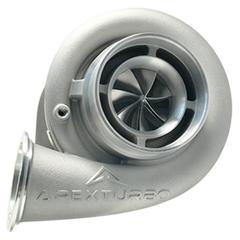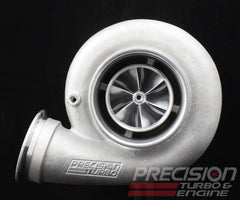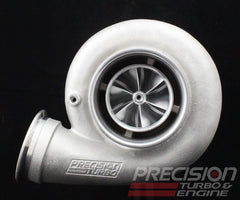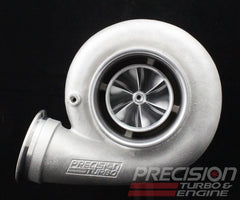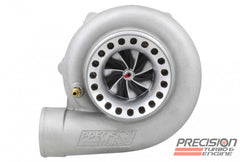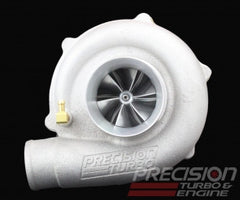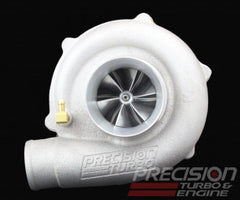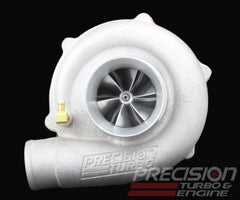BorgWarner S400SX 67mm FMW Turbo
Brand-new for 2012 - BorgWarner's 67mm S400SX FMW turbocharger is one of the most impressive 67mm turbos available. This unusually high power design pairs a 91mm OD FMW compressor wheel (forged billet, similar to EFR) with an ultra high flowing 83mm S400SX turbine wheel and 1.10 a/r (upgrade to 1.25 a/r available for 35+psi boost). This combination provides huge exhaust flow energy without restriction It shares identical fitments to the GT42R and S372R setups (bolt-on for a twinscroll T4 manifold and 4" downpipe).




The compressor stage starts with a ported shroud housing, including integrated velocity stack. Compressor wheel is BorgWarner's "FMW" forged-milled-wheel (AKA forged-billet) and uses the latest generation blade aero to reach ~94 lb/min max compressor flow. This is a journal bearing oil cooled only turbocharger ideally suited to competitive drag racing.
This turbo is an excellent choice for a Drag Race B-series engine. The airflow this turbo generates compliments high flowing VTEC cylinder heads and 83mm turbine wheel nicely. The S400SX turbos will fit Full-Race twinscroll turbo manifolds and 4" downpipes.
B-Series Honda: Jeff Evans recently tested an off-the-shelf 67mm S400SX turbo on the evans tuning drag Integra. He commented that no other engine/turbo combination has he had on his dyno create such an impressively broad powerband. The following dynochart shows the Evans Tuning integra at 31psi boost on E85:

UPDATE: Jeff Evans became the first 67mm turbo honda to run in the 8s! He did this at MIR worldcup, in the 'true street' class using a 100% off-the-shelf 67mm S400SX
H-Series Honda:The following dynochart compares the same 67mm S400SX to 71mm S400SX on Roger's 9.3 Second Prelude:

2JZGTE Toyota Supra:


About Twin-scroll: About Twin Scroll:Twin scroll turbo system design addresses many of the shortcomings of single scroll turbo systems by separating those cylinders whose exhaust gas pulses interfere with each other. Similar in concept to pairing cylinders on race headers for N/A engines, twin-scroll design pairs cylinders to one side of the turbine inlet so that the kinetic energy from the exhaust gases is recovered more efficiently by the turbine. For example, if a four-cylinder engines firing sequence is 1-3-4-2, cylinder 1 is ending its expansion stroke and opening its exhaust valves while cylinder 2 still has its exhaust valves open (while in its overlap period, where both the intake and exhaust valves are partially open at the same time). In a single scroll AKA undivided manifold, the exhaust gas pressure pulse from cylinder 1 is therefore going to interfere with cylinder 2s ability to expel its exhaust gases, rather than delivering it undisturbed to the turbos turbine the way a twin scroll system allows.
The result of the superior scavenging effect from a twin scroll design is better pressure distribution in the exhaust ports and more efficient delivery of exhaust gas energy to the turbochargers turbine. This in turn allows greater valve overlap, resulting in an improved quality and quantity of the air charge entering each cylinder. In fact, with more valve overlap, the scavenging effect of the exhaust flow can literally draw more air in on the intake side while drawing out the last of the low-pressure exhaust gases, helping pack each cylinder with a denser and purer air charge. As we all know, a denser and purer air charge means stronger combustion and more power... but the benefits of twin scroll design dont end there. With its greater volumetric efficiency and stronger scavenging effect, higher ignition delay can be used, which helps keep peak combustion temperature in the cylinders down. Since cooler cylinder temperatures and lower exhaust gas temperatures allows for a leaner air/fuel ratio, twin scroll turbo design has been shown to increase turbine efficiency by 7-8 percent (faster spool, quicker response) and result in fuel efficiency improvements as high as 5 percent. It is wise to size the turbine housing A/R larger than the single scroll turbine A/R typically used!




The compressor stage starts with a ported shroud housing, including integrated velocity stack. Compressor wheel is BorgWarner's "FMW" forged-milled-wheel (AKA forged-billet) and uses the latest generation blade aero to reach ~94 lb/min max compressor flow. This is a journal bearing oil cooled only turbocharger ideally suited to competitive drag racing.
This turbo is an excellent choice for a Drag Race B-series engine. The airflow this turbo generates compliments high flowing VTEC cylinder heads and 83mm turbine wheel nicely. The S400SX turbos will fit Full-Race twinscroll turbo manifolds and 4" downpipes.
B-Series Honda: Jeff Evans recently tested an off-the-shelf 67mm S400SX turbo on the evans tuning drag Integra. He commented that no other engine/turbo combination has he had on his dyno create such an impressively broad powerband. The following dynochart shows the Evans Tuning integra at 31psi boost on E85:

UPDATE: Jeff Evans became the first 67mm turbo honda to run in the 8s! He did this at MIR worldcup, in the 'true street' class using a 100% off-the-shelf 67mm S400SX
H-Series Honda:The following dynochart compares the same 67mm S400SX to 71mm S400SX on Roger's 9.3 Second Prelude:

2JZGTE Toyota Supra:


About Twin-scroll: About Twin Scroll:Twin scroll turbo system design addresses many of the shortcomings of single scroll turbo systems by separating those cylinders whose exhaust gas pulses interfere with each other. Similar in concept to pairing cylinders on race headers for N/A engines, twin-scroll design pairs cylinders to one side of the turbine inlet so that the kinetic energy from the exhaust gases is recovered more efficiently by the turbine. For example, if a four-cylinder engines firing sequence is 1-3-4-2, cylinder 1 is ending its expansion stroke and opening its exhaust valves while cylinder 2 still has its exhaust valves open (while in its overlap period, where both the intake and exhaust valves are partially open at the same time). In a single scroll AKA undivided manifold, the exhaust gas pressure pulse from cylinder 1 is therefore going to interfere with cylinder 2s ability to expel its exhaust gases, rather than delivering it undisturbed to the turbos turbine the way a twin scroll system allows.
The result of the superior scavenging effect from a twin scroll design is better pressure distribution in the exhaust ports and more efficient delivery of exhaust gas energy to the turbochargers turbine. This in turn allows greater valve overlap, resulting in an improved quality and quantity of the air charge entering each cylinder. In fact, with more valve overlap, the scavenging effect of the exhaust flow can literally draw more air in on the intake side while drawing out the last of the low-pressure exhaust gases, helping pack each cylinder with a denser and purer air charge. As we all know, a denser and purer air charge means stronger combustion and more power... but the benefits of twin scroll design dont end there. With its greater volumetric efficiency and stronger scavenging effect, higher ignition delay can be used, which helps keep peak combustion temperature in the cylinders down. Since cooler cylinder temperatures and lower exhaust gas temperatures allows for a leaner air/fuel ratio, twin scroll turbo design has been shown to increase turbine efficiency by 7-8 percent (faster spool, quicker response) and result in fuel efficiency improvements as high as 5 percent. It is wise to size the turbine housing A/R larger than the single scroll turbine A/R typically used!
Additional Information:
- Max warm oil pressure: 5 bar (73.5psi)
- Max cold oil pressure: 8 bar (118psi)
- When starting a fresh engine build or in extremely cold climates - oil pressure must reach 0.5bar (7.2psi) within 4 seconds maximum.
- Do not load the engine with full boost and WOT until full operating oil pressure is present
- Do not load the engine with full boost and WOT if any boost leaks are present (this can result in turbocharger overspeed





